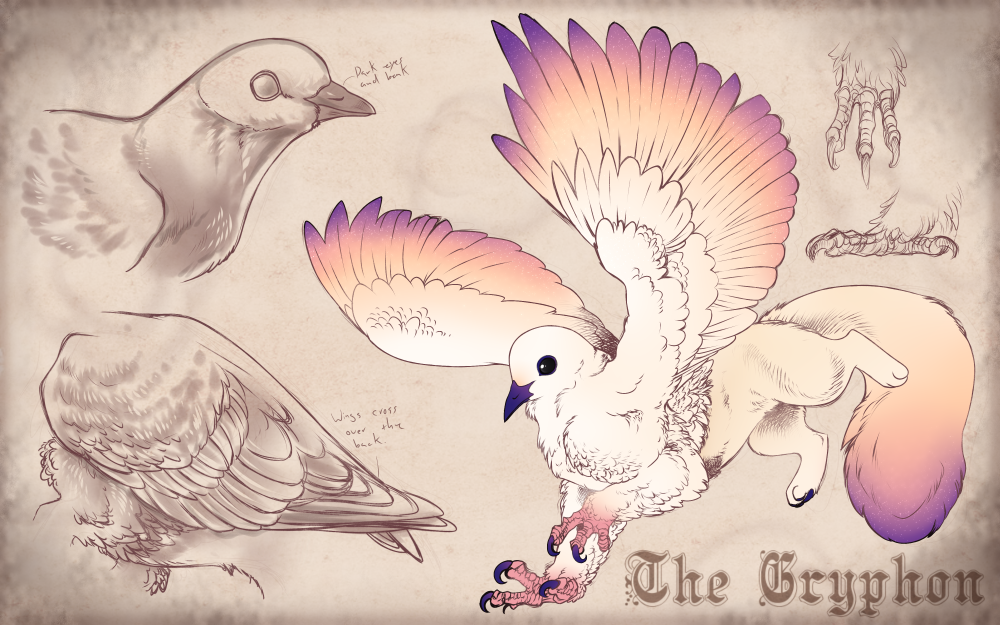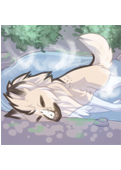Tokopedia
Gryphon
Description:
Gryphons vary in fur and plumage colors, though the most common are off-white with rose and lilac tones, likely due to the influence of their patron deity Sikrinerk.
They come in sizes ranging from that of a pigeon to the average cat, with wings sized to match.
Thought to have become extinct thousands of years ago, they were rediscovered in Sikatou.
Lore:
In older literature and art, gryphons were depicted with more feline features such as manes. Historians are unsure if this was something that had since evolved out of the Sikatou gryphons due to their biome, or were simply rather artistic interpretations of artists at the time. Due to the dense forest floors, these hypothetical long, royal manes wouldn't do these hunters any good; instead they would get in the way, especially with their sharp talons! However, that doesn't stop certain communities from theorizing regional variants beyond the Sikatou branch.
These works also include mentions of larger gryphons, powerful foes made up from lions and eagles. Though the gryphons within Sikatou are no bigger than the average housecat and playful compared to the legends of powerful creatures, they can still present a threat as a flock if provoked.
Modern gryphons have widely-varying feather patterns and types that can often provide clues as to where they live within Sikatou. For example, gryphons with sleeker 'oiled' feathers are most often found around the bodies of water which exist within the cavern. Heavier plumage and thicker layers of feathers, on the other hand, belong to gryphons living in colder areas such as the glacier. This diversity is only expected to increase as gryphons move outside of Sikatou, as the legends of when they roamed all of Tokotna describe a wide variety of feathers and forms. It is uncertain how they have been hidden away in the caves for so long without discovery.
Because a fair number of them share colors with Sikrinerk, it is theorized they were perhaps created to help Sikrinerk chase down the dark spirits within the dreams of the young due to their small and agile size.
Gryphon feathers are often collected as trinkets, but you better be wary of the gryphons coming to look for their lost plumes.
Behavior:
The species is incredibly social, forming flocks of various sizes - some family groups, some larger alliances. When in flight, they take turns to chirp at each other to check in and locate each other, ensuring the caverns of Sikatou are filled with almost constant noise.
They can also mimic a wide variety of sounds, which become incorporated into the flock’s dialect, which varies between regions. Through recording these sounds, researchers believe each creature might have its own unique name sound that may change as it develops mentally from fledgling to adulthood.
It’s unclear what they mean by mimicking the sound of rustling clothes or boots trudging along the cavern gravel, but it can sometimes cause alarm for weary travelers who may believe they are being followed. Similarly, their mimicry of research equipment sounds, particularly analysis completion pings, can hamper research efforts.
One researcher reported he observed an encounter between what we believe are two family groups. The head of each group prowled forward to meet in the middle, their feathers fluffed up on edge. When they seemed to encounter no obvious threat to either territory they bowed their necks low, which signaled to the others and they all began to play and interact, grooming each other.
Preening is often used as a way for gryphons to strengthen their bonds with their family, but it’s also a way for them to show dominance over other gryphons. This behavior is similar to that of big cats, who will aggressively groom lower-ranking cats. A higher-ranking gryphon may approach another flock mate and begin straightening out their feathers and pulling out pins, revealing their hierarchy.
Despite a seemingly pudgy and soft appearance, the gryphons are surprisingly agile and sleek. Their wings and feathery fluff tuck in tight against their bodies to allow them to enter cracks and crevasses inaccessible to most animals in their environment. This allows for both excellent hiding spots, and easy time securing insects and small rodents as prey.
Perhaps as a result, the gryphons are quite eager to enter any and all kinds of bags, supply crates and pouches, raiding them for their edible contents. All travelers are encouraged to make their supplies doubly secure to avoid making a ‘donation’ to the gryphons’ food stores.
Gryphons are noted for their complex play rituals which seem to be closely tied to their social standing within their group. Higher status gryphons will soar above the others and drop mushroom chunks while cawing, expecting the others to catch them and then throw them back. This play can result in spectacular aerial displays of gryphons flying in loops and upside down while throwing pieces of mushroom back and forth.
Upon spending an extended period of time with the gryphons, it was discovered their nature is primarily mischievous. They seem to enjoy pulling pranks, tugging hair, and doing fake-out divebombs. However, it's worth noting that intruding on a gryphon's nest can agitate them to the point of true aggression. It's important to note that a gryphon's beak and talons are sharp enough to easily penetrate human skin, and it is recommended that thick protective leather be worn if one attempts to gather a wild egg.
Domestication:The remarkable diversity of landscapes found in the gryphon's natural habitat has in turn created a hardy, adaptable species. Domesticated gryphons are not recommended for the inexperienced handler; without enough enrichment or exercise, gryphons can become incredibly destructive for their diminutive size. This is due to the fact they are naturally intelligent and take great joy in play. It is generally not recommended to own only one gryphon at a time, as they have a tendency to grow depressed without at least one other companion.
Humans can become accepted into flocks relatively quickly if they offer food bribes and do not threaten the nests. Youngsters, in particular, are quick to learn tricks in exchange for further treats, though will often teach themselves such skills as going through the researcher’s bags and prying open sealed containers.
Lifecycle:
In the winter months, gryphons will separate into bachelor roosts, consisting of either females and very young fledglings, or males that are yearlings and beyond. Usually these "roosts" will stay largely in or around the sections of Sikatou that stay warmer, such as those near the lava falls.
Most roosts consist of at least 40 individuals at any given time, but the population may be considerably higher or lower depending on the suitability of the surrounding area.
When spring comes, these male and female roosts will meet in high altitude clearings; mated pairs will reform, or new pairs will form as the mass gathering filters off to individual small territories.
During these meetings, unmated males will form display grounds on large branches or mushroom caps, decorating the area with as many morsels of food as they can find, usually a variety of berries, mushrooms, bugs and rodents. It is not unheard of for either a male or female gryphon to take a collection of mates numbering up to four, but this is rare.
Gryphons have the yearly ritual of laying eggs. This usually occurs in a treetop nest. Similar to felids, gryphons have an average litter size of four to six kits. For the first few weeks, the mother will feed the kits special milk produced by her crop until they can handle solid foods. Then while she is away, the kits spend a good deal of time playing, stalking, pouncing, and chasing their siblings. These behaviors function to hone their own hunting skills and stretch their wings in preparation for their fledging.
Creature compiled from contributions by CosmicReality, DoctorLinnec, Ellanoire, FRATARPG, Lem0nlion, Pardicolor, princejackdaw, RuneHarpy, Shiibasu, Skeithy, Skypoot, ThatDenver, Viscella and the Tokotas Admin Team
Creature art by FantasyToArtt

